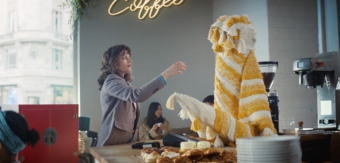In the 1940s, some flour mills started to use patterned fabric for their flour sacks after they realised that the fabric could be re-used to make children's clothes. This direct response to world events helped to foster goodwill with customers.
(Image via gina pina on Flickr, recoloured using AI).
Amid talks of recession, some may feel that expenditure on creative services such as brand, design and website development should take a back seat in their business strategy. However, there are many examples that suggest this is not the best move. Let’s take a look at how best to approach this vital business activity during times of financial uncertainty.
'Recessions present a valuable opportunity for brands to reinvent themselves. When recessions hit, customers usually reconsider their priorities, and brands can use this time to strengthen their position in the market and set themselves apart from the competition. By recognizing the risks, and executing a rebranding that aligns with cultural, technological and societal shifts, you can strengthen your business.'
– ‘Why a recession is the time to double down on brand’, The Drum
There are many examples of companies that have found success during difficult times: especially when they’ve made the decision to continue investing in their brands. Let’s take a look at some companies who did exactly this, despite facing financial uncertainty, and have reaped the rewards. According to The Drum:
- Amazon was able to increase sales by 28% during the global financial crash. They did this by expanding their product offering to align with what consumers needed during this time.
- Samsung rebranded during the global financial crisis of the late 2000s. This rebrand allowed Samsung to ‘become a more customer-driven innovation company as it doubled down on research and development investments’.
- In 2019, AirBnB decided to shift their marketing strategy to be more brand-driven. They continued with this new strategy throughout the pandemic, and by the end of 2022, AirBnB had achieved their ‘strongest ever” fourth quarter results’.
This phenomenon is not unique to the 21st century. In the 1940s, some Americans began sewing children’s clothes out of flour sacks in an attempt to keep costs down and support the war effort. When one flour mill realised this was happening, they started using brighter, floral fabrics to bag their flour.
'Other mills caught on to the tactic and then started developing their own fashionable packaging. From pastels to novelty prints, the competing mills would play the game of “who can develop the most attractive pattern?'
– ‘Flour Sacks & Pretty Clothes’, EatWheat.org
Images of these floral flour sacks still circulate social media today, proving that times of financial hardship can be opportunities for brands to make history.

When one flour mill realised that people were using the fabric from their flour sacks to sew clothes, they started using brighter, floral fabrics to bag their flour.
(Image via Medium)
"Stopping advertising to save money is like stopping your watch to save time."
Henry Ford
Moving away from the 1940s, there’s even more evidence that it’s worth investing in branding now.
One example comes from even further back in time: a study from 1927. Roland Vaile evaluated the success of 250 companies in the U.S, following the companies from the post-war recession to the 1920s. The study found that the companies who had increased their marketing budgets during the recession increased sales by 20%. Conversely, companies who had reduced their marketing spend saw a 7% drop in sales.
Decades later, the same trend was still evident: a 2002 McKinsey & Company study assessed around 1,000 US companies across 18 years (including a period of recession from 1990–1991).¹ In this study, the companies that performed the best were those that had invested continually in marketing. Some of these companies even spent more on marketing during the recession than during periods of economic growth.
The pattern seems to repeat across history—but what’s behind this? According to Forbes, continuing to invest in branding can help maintain consistency and foster trust:
'Fine-tuning your brand is a great way to refine your brand perception with your customers, investors and employees—who are all key players in navigating this economic climate. When people are less likely to spend money, they’re more likely to go with brands they trust.'
– ‘Lead With Your Brand Through A Recession’, Forbes
It seems that success favours those who invest in their brand through thick and thin. So, if you’ve been thinking about rebranding, refreshing your website, or updating the design of any customer-facing materials, there is no reason to wait.






